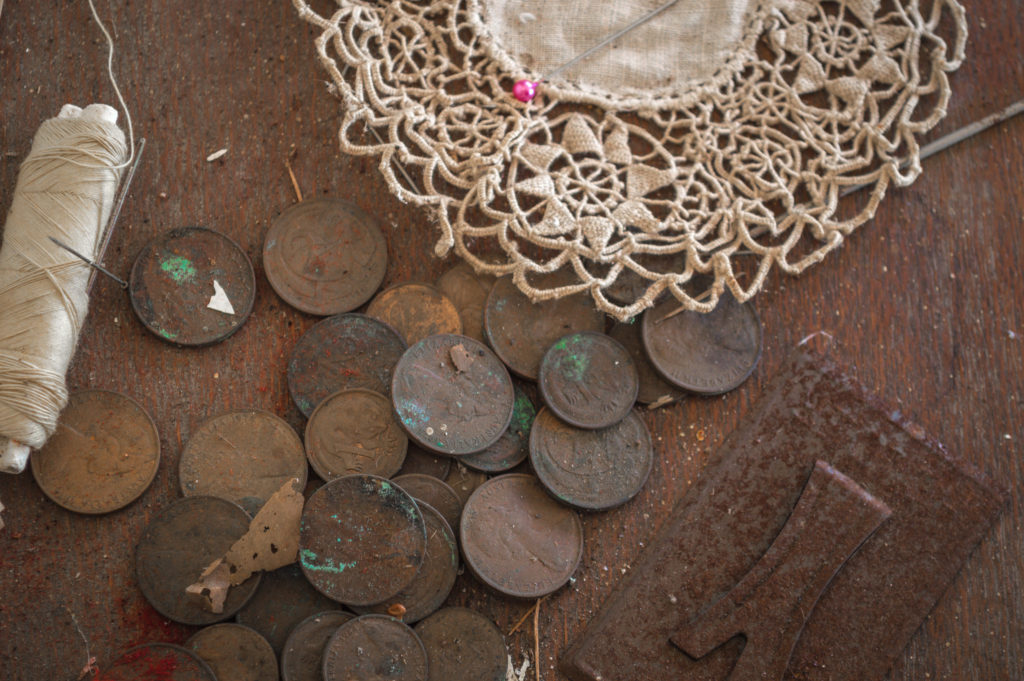
Posted in: World Wedding Customs
 A German daughter saves up coins for all her life until she can buy her wedding shoes after her betrothal. Photo courtesy Flickr.
Though a German betrothal begins when a man proposes, many German women prepare for their marriage long before this. For example, a young German maiden saves her pennies all her life until a man proposes marriage. Then, she uses those pennies to buy her wedding shoes.
Meanwhile, if her parents follow with ancient traditions, upon her birth they plant a number of trees in her honor. When a suitor pledges marriage, they cut the trees down and sell them to provide her dowry.
A German daughter saves up coins for all her life until she can buy her wedding shoes after her betrothal. Photo courtesy Flickr.
Though a German betrothal begins when a man proposes, many German women prepare for their marriage long before this. For example, a young German maiden saves her pennies all her life until a man proposes marriage. Then, she uses those pennies to buy her wedding shoes.
Meanwhile, if her parents follow with ancient traditions, upon her birth they plant a number of trees in her honor. When a suitor pledges marriage, they cut the trees down and sell them to provide her dowry.
A Promise is Made
Today, German betrothal begins with an exchange of gold bands worn on the fourth finger of their left hands. These engagement rings serve as a pledge of their plans to marry. During the ceremony, they transfer the bands to the fourth finger of their right hands. Right away, the couple is dubbed the bride and the bridegroom. Traditionally, their families and friends consider them practically married. The rings serve as a binding promise.The Banns
Once a date for the wedding is announced, they arrange for a reading of the banns. I've actually come across this custom in other European betrothal traditions. The Banns is a formal announcement, typically made three Sundays in a row at the couple's local church. Some parishes require a reading of the Banns three times over the course of three months prior to the wedding. In the case where the bride and groom hail from different parishes (church neighborhoods or towns), the Banns must be read in both churches, as well as in the church in which the ceremony will take place. Traditionally, the Banns offered members of the community to come forward with legal reasons to halt or postpone the wedding. Although I see no lists of reasons a person might propose to halt a wedding, I can imagine a few. Perhaps the bride has lied about her age and someone comes forward with proof that she fails to meet the legal age requirement. Perhaps the groom habitually proposes, and Banns for another of his supposed weddings were read in a different parish church. I know, a bit morbid and out of character from my usual posts. I can jest because typically the reading of the Banns provides a wonderful opportunity for the community to celebrate the couple. It is far more likely that people will come forth with blessings, gifts, or invitations to parties than to try to stop the wedding these days.The Inviter
After the reading of the Banns, the couple designates an official Inviter. I picture the Inviter as a sort of jolly jester who walks from home to home personally inviting neighbors, friends, and family members to the wedding. He wears a plain hat and a jacket adorned with ribbons. He also carries a special stick decorated with colorful ribbons and flowers. The couple's friends and neighbors do their part by taking a ribbon from his stick and pinning it to his hat. Then, they invite the Inviter into their home for a good stiff drink. Sometimes the inviter reaches his limit before finishing his rounds. In this case, he either completes his rounds the next day, or the remaining neighbors and friends understand that the invitation extends to them, as well. On the eve of the wedding, the Inviter serves as the emcee for the reception. In many ways, his role mimics the role of the best man in American weddings.Polterabend, a German Betrothal Party!
A German betrothal includes a very special party which takes place the night before the wedding. Finding its roots in more superstitious times, originally the polterabend ("noisy evening") provided a means for well wishers to scare off evil spirits. As such, the party includes a lot of raucous noise. Invitations to this German betrothal party are implied and spread by word of mouth. Throughout the evening, people show up to enjoy a feast provided by the bride's relatives. Attendees bring their own pots, pans, and crockery. Throughout the evening, the bride wears a myrtle crown, which she may wear on her wedding day, as well. After the feasting and the drinking, at around midnight, the partygoers take their pots, pans, and crocks and throw them violently against the door. Thus, the night of noise ends, with the evil spirits fleeing far away as the bride and bridegroom work together to clean up the atrocious mess.Two Final Traditions
During the final weeks before the wedding, some of the bride's and groom's friends prepare a special fundraiser for the couple. They gather photos and stories of the couple's early lives, as well as fun stories of their dating and betrothal periods. These friends put together a special newspaper featuring photos, articles, and other tidbits about the bride and groom and their relationship. During the reception, they offer this newspaper for sale to raise funds for the couple's honeymoon. The final act of a traditional German betrothal is the conveyance of the bride's trousseau to the bride's new home. This act signaled the beginning of the wedding. In more modern times, the trousseau arrives at the church just before the ceremony. Wedding attendants arrange the trousseau for public display. Originally, the trousseau and dowry were one and the same. Putting it on display demonstrated the wealth and status of the bride's family. Often, guests at the wedding added more gifts for the bride on her special day.6 years ago
23 view(s) 